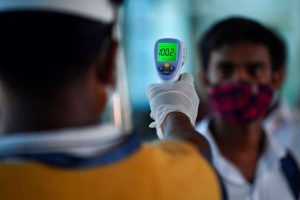MAY 18, 2020

A railway staff checks the temperature of a migrant worker at a train terminus before he prepares to board a train for his journey back home during a nationwide lockdown, in Mumbai, India, on May 8.
As the third phase of the nationwide lockdown ended on Sunday, the Centre announced an extension till May 31, but listed considerable relaxations in non-containment zones that are set to further open up the economy.
While all markets, offices, industries and businesses will be allowed to open, inter-state and intra-state movement of “passenger vehicles and buses” will be permitted with the consent of the states involved.
Significantly, in its guidelines for Phase IV of the lockdown beginning Monday, the Ministry of Home Affairs (MHA) said the “delineation of red, green and orange zones will be decided by the state and UT governments after taking into consideration the parameters shared by the Ministry of Health and Family Welfare.”
The district authorities have been told to demarcate “containment” and “buffer” areas within red and orange zones as per the Health Ministry’s guidelines.
Ownership of response with states
After steering the first three phases, the government has decentralized the fourth step by asking states to take charge of the lockdown. It also means that states will have more ownership of the Covid-19 response.
While the Centre was taking these decisions till now, many state governments had objected to an entire district being listed as a red or orange zone or an entire municipal area being demarcated as a hotspot. They had said this restricted their elbow room to kickstart the economy, especially in entirely urban areas like Delhi.
Under the new guidelines, “the zones can be a district, or a municipal corporation/ municipality or even smaller administrative units such as sub-divisions, etc, as decided by states and UTs,” an MHA statement said.
The decision to allow inter-state travel — including buses — will greatly ease public transportation, providing relief to migrant labourers on the roads.
The restrictions on air travel (domestic and international) and Metro rail services will continue, and schools, colleges and other educational institutes will remain closed. All social, political and religious functions and gatherings will still be barred, and places of worship will remain shut.
While hotels, cinema halls, malls, swimming pools, gyms will continue to be closed, restaurants will be “permitted to operate kitchens for home delivery” and “takeaway” only. “Sports complexes and stadia will be permitted to open; however, spectators will not be allowed,” the MHA said.
“All other activities will be permitted, except those which are specifically prohibited,” it said.
So all services, including those of barber shops, salons and spas, are likely to open. E-commerce delivery of non-essential items, which were earlier prohibited in red zones, have now been permitted. Cycle-rickshaws, auto- rickshaws and taxis will also be allowed.
The restrictions on the number of passengers in a car or on a bike in red and orange zones have also been lifted. Even for buses, while social distancing has been advised, the seating capacity cap of 50% has been removed.
However, movement of people will remain “strictly prohibited” across the country from 7 pm to 7 am, except for essential activities.
On the industrial side, all restrictions on factories and units across the country irrespective of zones (barring containment zones) have been removed. With public transport being allowed, construction companies are no longer required to use in-situ labour.
The clause on limiting attendance in private offices to 33% has also been removed. While offices can operate with 100% attendance if they want, the government has advised them to allow “work from home” as much as possible.
In the containment zones, only essential activities will be allowed. “There shall be strict perimeter control to ensure that there is no movement of people in or out of these zones, except for medical emergencies and for maintaining supply of essential goods and services,” the MHA said.
There shall be intensive contact tracing, house-to-house surveillance, and other clinical interventions, as required in these areas, it added.
The government reiterated that those above 65 years of age, pregnant women, people with co-morbidities, and children below 10 years should stay at home.
In the last lockdown guidelines, there were considerable restrictions in red zones, including a ban on plying of buses even within the zone as well as opening of market complexes and services which involve close contact with customers.
Now, with markets opening in red zones, liquor shops in these areas are also allowed to open, giving the much needed revenue fillip to states. Earlier, such shops in red zones were allowed to open only if they were standalone outlets.
However, the government specified that “states and UTs, based on their assessment of the situation, may prohibit certain other activities in the various zones, or impose such restrictions as deemed necessary.” But they “shall not dilute these guidelines”.
While in its last guidelines, the Centre had made use of Aarogya Setu app mandatory for employees in an office and put the onus of implementation on employers, the new guidelines have asked them to make “best efforts” in that direction. It also exempted people who do not have smart phones. The mandatory use of the app in containment zones has also been removed.
In the backdrop of some districts, like Noida in Uttar Pradesh, making the app mandatory, the MHA said that “district authorities may advise individuals to install the Aarogya Setu application on compatible mobile phones and regularly update their health status on the app. This will facilitate timely provision of medical attention to those individuals who are at risk.”
Taking cognizance of restrictions on movement of doctors and paramedics in some states like Haryana and UP, it specified that “all states/ UTs shall allow inter-state and intra-state movement of medical professionals, nurses and paramedical staff, sanitation persons and ambulances, without any restriction. All states/ UTs shall allow inter-state movement of all types of trucks including empty trucks.”
The MHA said that all its previous standard operating procedures issued in the context of migrant workers and movement of trains will remain in force.
“In order to facilitate the movement of persons, various modes of transport have already been opened up. Movement of individuals by trains has been permitted earlier by MHA through an order dated 11.5.2020. Further, evacuation of foreign nationals from India, return of stranded Indian nationals from abroad, sign-on and sign-off of Indian seafarers, and intra-state and inter-state movement of stranded persons by bus and train, will continue to be allowed,” it said.
It underlined that the protocol on social distancing and hygiene must be followed. “Local authorities should ensure that shops and markets open with staggered timings, so as to ensure social distancing. All shops shall also have to ensure six-feet distance among customers and not allow more than five persons at one time,” it said.
Wearing of masks shall remain compulsory while spitting will be punishable. Workplaces must be sanitised regularly and have provisions for thermal scanning and sanitisers.
The MHA’s guidelines followed the National Disaster Management Authority’s (NDMA) order directing all departments to “continue the lockdown measures up to 31st May, 2020.” It also directed the NEC (National Executive Committee) to “issue modifications in the guidelines as necessary, keeping in view the need to open up economic activities while containing the spread of Covid-19”.
The NEC, headed by Home Secretary Ajay Bhalla, is entrusted with issuing guidelines and orders for Covid-19 containment under the Disaster Management Act.
Meanwhile, Cabinet Secretary Rajiv Gauba held a video conference with chief secretaries of all states in the evening. Gauba requested all state officials to cooperate in running more Shramik Special trains for migrant workers, sources said. The Railway Board chairman, who also attended the meeting, assured that more special trains can be started if the states provide quick clearances, sources added.
Courtesy/Source: Indian Express










































































































